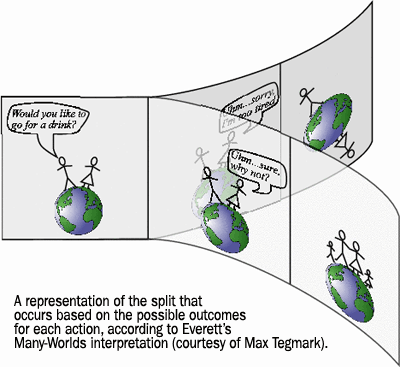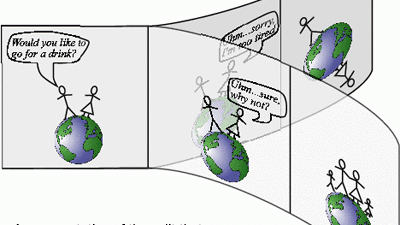How Quantum Suicide Works
Source: science.howstuffworks.com
The quantum suicide thought experiment is based on and seeks to prove what has become an increasingly accepted interpretation of quantum physics, the Many-Worlds theory. This theory was first proposed in 1957 by a doctoral student at Princeton University named Hugh Everett III. The theory was scorned for decades until fellow Princetonian Max Tegman created the quantum suicide experiment, which lends support to the interpretation [source: The Guardian].According to the Many-Worlds theory, for each possible outcome to an action, the world splits into a copy of itself. This is an instantaneous process Everett called decohesion. It’s kind of like a choose-your-own-adventure book, but rather than choosing between either exploring the cave or making off with the treasure, the universe splits in two so that each action is taken.

One vital aspect of the Many-Worlds theory is that when the universe splits, the person is unaware of himself in the other version of the universe. This means that the boy who made off with the treasure and ends up living happily ever after is completely unaware of the version of himself who entered the cave and now faces great peril, and vice versa.
This is the same case with quantum suicide. When the man pulls the trigger, there are two possible outcomes: the gun either fires or it doesn’t. In this case, the man either lives or he dies. Each time the trigger is pulled, the universe splits to accommodate each possible outcome. When the man dies, the universe is no longer able to split based on the pulling of the trigger. The possible outcome for death is reduced to one: continued death. But with life there are still two chances that remain: The man continues living or the man dies.
When the man pulls the trigger and the universe is split in two, however, the version of the man who lived will be unaware that in the other version of the split universe, he has died. Instead he will continue to live and will again have the chance to pull the trigger. And each time he does pull the trigger, the universe will again split, with the version of the man who lives continuing on, and being unaware of all of his deaths in parallel universes. In this sense, he will be able to exist indefinitely. This is called quantum immortality.
So why aren’t all of the people who have ever attempted to kill themselves immortal? What’s interesting about the Many-Worlds interpretation is that according to the theory, in some parallel universe, they are. This doesn’t appear to be the case to us, because the splitting of the universe isn’t dependent on our own life or death. We are bystanders or observers in the case of another person’s suicide, and as observers we’re subject to probability. When the gun finally went off in the universe -- or version -- we inhabit, we were stuck with that result. Even if we pick up the gun and continue shooting the man, the universe will remain in a single state. After all, once a person is dead, the number of possible outcomes for shooting a dead person is reduced to one.
But the Many-Worlds theory stands in contradiction to another quantum theory, the Copenhagen interpretation. In the next section, we’ll look at this theory and see why it changes the rules of quantum suicide.
The Copenhagen Interpretation
The Many-Worlds theory of quantum mechanics supposes that for each possible outcome of any given action, the universe splits to accommodate each one. This theory takes the observer out of the equation. No longer are we able to influence the outcome of an event simply by observing it, as is stated by the Heisenberg Uncertainty Principle.
But the Many-Worlds theory turns a widely accepted theory of quantum mechanics on its ear. And in the unpredictable quantum universe, this is really saying something.
For the better part of the last century, the most accepted explanation for why the same quantum particle may behave in different ways was the Copenhagen interpretation. Although it’s getting a run for its money from the Many-Worlds interpretation lately, many quantum physicists still assume the Copenhagen interpretation is correct. The Copenhagen interpretation was first posed by physicist Niels Bohr in 1920. It says that a quantum particle doesn’t exist in one state or another, but in all of its possible states at once. It’s only when we observe its state that a quantum particle is essentially forced to choose one probability, and that’s the state that we observe. Since it may be forced into a different observable state each time, this explains why a quantum particle behaves erratically.
This state of existing in all possible states at once is called an object’s coherent superposition. The total of all possible states in which an object can exist -- for example, in a wave or particle form for photons that travel in both directions at once -- makes up the object’s wave function. When we observe an object, the superposition collapses and the object is forced into one of the states of its wave function.
Bohr’s Copenhagen interpretation of quantum mechanics was theoretically proven by what has become a famous thought experiment involving a cat and a box. It’s called Schrödinger’s cat, and it was first introduced by the Viennese physicist Erwin Schrödinger in 1935.

[...]
Read the full article at: howstuffworks.com
Simple Many-worlds interpretation
Tune into Red Ice Radio:
Anthony Peake - Cheating The Ferryman & The Daemon
Anthony Peake - Quantum Weirdness & Precognition
David Wilcock - Convergence & The Divine Cosmos
Tom Campbell - Outside the Box, Technological Revolution, Entities & The Unconscious Mind






















